Nutmeg are the seeds of a tree known as Myristica fragrans (fragrant nutmeg). Ground nutmeg is a commonly used spice, and so is mace, the reddish seed covering the nutmeg seed. The chemical composition of ground nutmeg and that of mace are virtually identical.
What makes this spice interesting to me is that nutmeg may have psychoactive effects. In fact, it is said to be a deliriant hallucinogen, which can produce a dreamlike state of consciousness.
It also has interesting effects on dreams, such as inducing out-of-body experiences as well as vivid and lucid dreams and even improving dream recall. In high doses, it can supposedly produce space and time distortions, a feeling of detachment from reality, and even hallucinations.
As well as being a Spice of Dreams, nutmeg is also a Spice of Sleep, and can help you sleep deeper, and even treat insomnia.
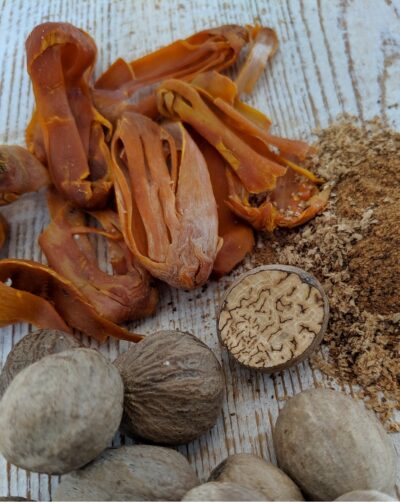
Before delving into the psychoactive properties of nutmeg, let’s take a look into some of its medical properties, benefits, and uses.
Nutmeg As a Medicinal Herb
Medicinally, nutmeg has many benefits, such as being a narcotic, an anesthetic, a carminative, a sexual and general tonic, and a folk treatment for fungal diseases, diarrhea, fever, asthma, heart disease, nausea, stomach spasms and pain, intestinal gas, cancer, kidney disease, depression, and anxiety, among other conditions.
Research suggests that nutmeg oil may be used a developed as a potent anti-cancer drug, as well as that it may possess anticonvulsant, antiangiogenic, and antidepressant properties.
Mace is known as javetri in Unani, a Perso-Arabic traditional medicine practiced in modern-day Central Asia. It is used as a hypocholesterolemic, anti-inflammatory, anti-diarrheal, and chemopreventive.
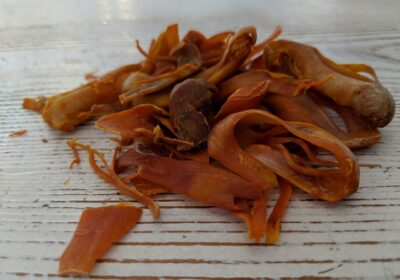
Myristicin, one of the active ingredients in nutmeg, has been known to have antibacterial and hepatoprotective effects.
Topically, an ointment can be made which is analgesic, especially for rheumatism, mouth sores, and toothache.
In homeopathic medicine, nutmeg is used to treat nervous complaints and perceptual disturbances.
Anecdotal evidence suggests that it might be hypotensive as well as elevate mood, while reducing stress and anxiety when taken regularly and in small amounts.
Nutmeg is an aphrodisiac and may help in treating sexual disorders by improving sexual function and enhancing the sex drive.
Nutmeg may also be considered a nootropic. Some people report being more attuned under its influence. Studies have found that while it may cause analysis and language suppression and thought deceleration and disorganization, nutmeg may also strengthen the brain and sharpen memory. Indeed, it is an ingredient in some herbal concentration-boosting supplements.
The observed memory-enhancing effect of the spice has been attributed to a variety of properties (individually or in combination) the plant is reported to possess, such as antioxidant, anti-inflammatory, or perhaps procholinergic activity.
Nutmeg is said to increase menstrual flow and has a history of use as an abortifacient. Whether it can induce abortions or not, it goes without saying that you should avoid nutmeg if you’re pregnant or breastfeeding.
The Psychoactive Effects of Nutmeg
Nutmeg as a Sleep Spice
While nutmeg is considered to be a sedative and relaxant, it’s not always easy to fall asleep under its influence.
Still, nutmeg can and is used as a sleep herb. Indeed, people report that they use it successfully as a sleep aid.
In Indonesia, the place of origin of Myristica fragrans, nutmeg is used to produce a mild sedative action and to treat insomnia. Children and those suffering from sleep disorders are often given ground spice with milk or a banana drink.
Nutmeg as a Dream Spice
More than it is a Sleep Spice, nutmeg is a Spice of Dreams.
In low doses, it produces an inebriation that feels like a combination of alcohol intoxication and cannabis “high.” Indeed, the spice is often used as a cannabis substitute by people who are unable to procure marijuana, such as kids and prison inmates.
In higher doses, the effects may include laughter, emotion enhancement, confusion, depersonalization, time distortion, disorientation, and visual, auditory, and tactile hallucinations (including double or blurry vision, full-fledged visions, and a perception of bodily heaviness). Sensations of floating, disturbances of the body schemata, shamanic journeys, and even out-of-body experiences have been reported under the influence of this magical spice.
The effects of nutmeg intoxication tend to be milder than those of other deliriants. It is even considered pleasant and euphoric by some who enjoy its long and smooth building up of the effects (though the trip may be dysphoric at times). The dosage you take will determine if your experience will be uncomfortable or pleasurable.

What accounts for the psychoactive effects of nutmeg?
Nutmeg contains myristic acid, trimyristin, fatty acid glycerides, as well as volatile compounds (essential oil), such as terpenes, including pinene, limonene, borneol, terpineol, geraniol, traces of safrole (possibly carcinogenic and toxic to the liver), elemicin, eugenol, and myristicin (~4%).
The oil produced from nutmeg leaves may contain up to 10% myristicin.
While trimyristin may be responsible for the sedative effect of nutmeg, myristicin, elemicin, and safrole appear to be responsible for the spice’s hallucinogenic effects.
Apparently, a chemical process takes place in our body, which transforms these substances into amphetamine derivatives.
- Myristicin yields MMDA, a known entactogenic compound.
- Elemicin is transformed into TMA, a substance related to mescaline.
- Safrole amination results in MDMA, which is known as ecstasy or the “love drug.”
Myristicin
A possible mechanism of action underlying the psychoactivity of myristicin was suggested by Alexander Shulgin who speculated myristicin could be metabolized to MMDA in the liver, a psychedelic and entactogen drug of the amphetamine class. Here’s an excerpt from PiHKAL:
The major essential oil from that spice is myristicin, and it is the easiest source of MMDA. It has been reported that the passage of this oil through the liver of a rabbit will generate MMDA in that animal. The only difference between the two molecules, structurally, are the elements of ammonia. Myristicin plus ammonia gives MMDA.
In fact, Shulgin was apparently able to make MMDA from the oil of nutmeg by distillation. The boiling point of myristicin was 110-115 °C.
Although myristicin has been pharmacologically demonstrated to have a mild monoamine oxidase (MAO)-inhibiting effect, it is likely not suitable for use as an ayahuasca analog.
Myristicin may also have serotonergic properties (a serotonin receptor antagonist).
Another explanation for myristicin’s psychotropic and hallucinogenic properties is the fact that it is an anticholinergic.
What’s an anticholinergic?
It’s a substance that blocks the neurotransmitter acetylcholine in the nervous system, thereby leading to decreased acetylcholine levels, causing delirium, characterized by intensely realistic hallucinations. High doses of nutmeg can cause intoxication that includes anticholinergic symptoms, such as a dry mouth, increased heart rate, visual disturbances, and euphoria.
An explanation for nutmeg’s cannabis-like effects was provided by a group of researchers who found that it interacts with the endocannabinoid system via inhibition of the endocannabinoid catabolizing enzymes. This may also suggest why nutmeg could potentially be a great cannabis additive.
There is also a theory that this spice works similarly to the mescaline in Peyote, affecting the brain by enhancing the neurotransmitter norepinephrine.
Myristicin is also present in other plants, including dill (another surprising aphrodisiac and inebriant, which when dried and smoked, induces mild euphoria), black pepper, carrot, celery, lovage, parsnip, parsley, Gold Pepper (Piper auritum), and Sassafras Tree (Sassafras albidum). The essential oil of the Australian Zieria species contains up to 23.4% myristicin.
Elemicin
Taking pure myristicin does not produce the same results obtained from ingestion of the entire nutmeg, suggesting that there’s something else in it that contributes to the psychotropic effect besides myristicin. Moreover, myristicin is not a major component of the seed.
Shulgin believed that elemicin is metabolized in the body to TMA, a psychedelic hallucinogenic drug,
Elemicin is also an anticholinergic and is believed to have similar effects to myristicin. It is active at the brain’s 5-HT receptors and displays anti-depressant, hallucinogenic, anti-histamine, hypotensive, and anti-serotonergic properties.
Safrole
Shulgin believed that safrole is metabolized in the body to MDA (an empathogen-entactogen, psychostimulant, and psychedelic drug of the amphetamine family).
Safrole is found in cloves and in the sassafras tree. Safrole is one of the most important precursors for the synthesis of MDMA, or “Ecstasy.”
How to Use Nutmeg
There are many ways to use nutmeg, which in significant quantities may bring about a marijuana-like “high” and mild hallucinations.
Nutmeg powder can be sniffed through the nose on its own or with other ingredients. Storm’s Breath is a snuff used to improve concentration and increase energy. It contains the spice in addition to guarana, cinnamon, and kola nut.
Nutmeg can also be vaporized, smoked, or burned as incense. The incense made from the spice is said to be psychedelic, aphrodisiac, mood-enhancing, and relaxing.
Since the active ingredient in nutmeg is an essential oil, you could theoretically induce a psychoactive effect just by inhaling the oil. So if you prefer not to eat any nutmeg, you can always try to sprinkle some essential oil on your pillow or use an oil diffuser or a different home fragrance accessory.
A few drops can be sufficient to produce clear psychoactive effects when dripped directly under the tongue.
Myristicin may also be injected into the veins.
The most common method of delivery, although the slowest, is eating or drinking nutmeg powder. Since myristicin is insoluble in water, tea cannot be made from the spice. It is soluble in ethanol though, therefore a tincture can be prepared (or purchased). If you prefer to drink tea, then simmer the ground powder in milk or in a different oily liquid. Cover the pot during preparation and while waiting for the liquid to cool down. The higher the fat content in the liquid, the more active ingredients will be extracted into it instead of evaporating. Strain the liquid through a cheesecloth and drink.
Some people simply mix the powder in a liquid, such as milk, orange juice, or Coca-Cola, and drink it. In fact, safrole and myristicin were found in many commercially-available cola-flavored soft drinks.
Others incorporate the spice in larger than usual quantities to normal recipes (e.g., cinnamon cookies, pumpkin pie). A recipe as well as lots of good information can be found here.
The powder can be inserted into capsules and swallowed.
It is reported that mixing the ground nutmeg in a cold drink (such as lemonade daiquiris) and then freezing it, makes ingesting this spice a lot more tolerable.
Others recommend just putting the powder deep in the mouth and swallowing it with some lemonade as if you are taking a pill.
Nutmeg – Oral Dosage
To produce a mild intoxication lasting about 12 hours and followed by deep sleep, 5-20 grams of nutmeg powder (1-3 whole seeds) are eaten, while 2-3 nutmeg seeds are regarded as a hallucinogenic dosage.
One nutmeg yields approximately one tablespoon of ground nutmeg and weighs about 6-7 g.
You can test the potency of nutmeg by inserting a needle into the nut. If it is fresh, a drop of oil should bubble up after pulling the needle out.
Ideally, the nutmeg powder should be freshly grated/powdered since myristicin tends to decrease in varying degrees after the nutmeg is processed.
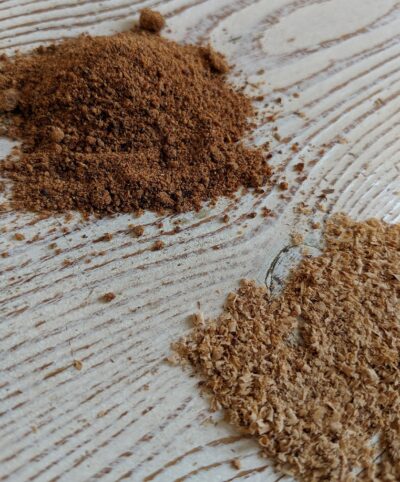
While some recommend eating 0.75-1.25 grams per 10 pounds (4.5 kg) of body mass, there may be varying myristicin content in ground nutmeg powder. Therefore, always start at lower doses, and gradually increase the dosage by small amounts until desired effects are experienced. I recommend starting with the threshold dose, then waiting for several days before trying a slightly higher dose, if needed. If you buy a new sample, then restart the process at the lower dose.
Myristicin content in mace may be double that of nutmeg, making it potentially stronger (and requiring a 50% smaller dose.)
Threshold Dose
The threshold dose is said to be 1-5 grams (up to 1.5 tsp). At this dose, expect to experience euphoria, relaxation, mood elevation, hilarity, and sensory enhancement. It’s rather easy even for the average person to enjoy the boost in confidence and positive outlook and anxiety alleviation provided by even a quarter or even half a teaspoon in a hot beverage or meal.
When using nutmeg as a sleep spice, a very small dose (1-2 grams at the most, about 4-8 hours before bedtime) may suffice. Try eating this soup for lunch or early supper:
Recipe – Black Lentil Soup for Joyful Nights & Better Sleep
Stir-fry onion with a bit of olive oil, mushrooms, and garlic. If you want, add vegetable stock or some carrots, celery, parsnips, and water. Add cooked black lentils. In addition to a quarter-half teaspoon of freshly ground nutmeg/mace, I add the following spices: chili powder, ginger, cumin, coriander seed, turmeric, and black pepper. Add some salt or fresh lemon juice, if you like. Sprinkle some parsley or dill on top and enjoy!
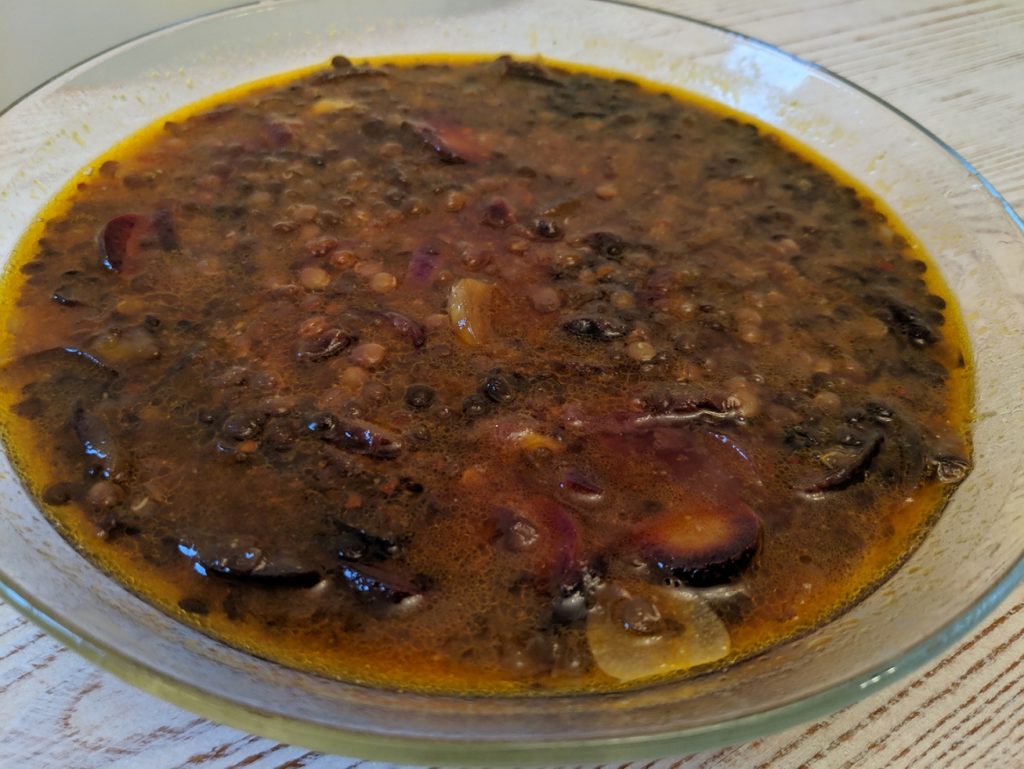
Light-Common Dose
5-15 grams (up to 1.5 tbsp) is considered a light dose. At this dosage, you may also experience visual distortions, closed-eye visuals, and auditory hallucinations, in addition to impairment of short-term memory, slurred speech, disorientation, and loss of coordination.
Commonly up to 20 grams (2 tbsp) may be taken by those who want to experience a waking dream-like state. However, side effects may be much more pronounced at this dosage.
Strong Dose
Anything above 20 grams is considered a strong dose, which may increase the perception of being in a dream world.
Never take more than 25 grams (2.5 tbsp) of nutmeg. Taking so much nutmeg will only make you sick without increasing the psychoactive effects of the spice.
Pure Myristicin
When taking pure myristicin, a light dose is 50-200 mg, while a common dose is 200-500 mg. A guideline to go by is to take 6-7 mg of myristicin per kg body weight.
Stages of Nutmeg Inebriation
There are 3 stages of nutmeg inebriation, which are:
Stage 1 – Threshold and Initial Inebriation (1-8 hours)
During the first hour, only subtle effects are felt.
The major effects of nutmeg inebriation build up and rise in waves over several hours. 3-4 hours after eating the nutmeg, you should expect to experience a sort of alcohol/pot-like buzz, lasting up to about 8 hours.
You may feel energetic and relaxed at the same time. Laughter, amusement, difficulty concentrating, and enhancement of sensory perception may be accompanied by physical symptoms such as a headache or lightheadedness, dry mouth, and eye redness.
Towards the end of this stage, you may start experiencing closed-eye visuals, time distortion, and the beginnings of slurred speech. This is when reality may take on a dream-like nature.
Stage 2 – Peak (8-18 hours)
By now, you should start experiencing a dream-like state of consciousness, which can be used for some interesting exploration whether you are alone or with a fellow traveler.
It can take up to 9-12 hours before maximum effect is experienced. The peak may last 3-4 hours.
Most primary effects, including auditory hallucinations, closed-eye visuals, and possibly open-eye visuals such as wall breathing and peripheral vision disturbances, occur during this stage, although they can last up to 24 hours.
Other symptoms of this stage are slurred speech and loss of coordination (as if you were drunk). The peak should be over around the 13th hour, followed by a gradual decrease in effects.
As the effects of nutmeg inebriation subside, it sometimes becomes possible to control the switching back and forth between states of consciousness.
This stage often culminates in sleep, which for some people is quite long, deep, and almost coma-like.
Stage 3 – Residual Effects (18-32 hours)
By now, the main effects should wear off, though you may still feel stoned, weak, or tired for 7-8 hours.
If you sleep during this stage, expect to experience vivid and easy-to-remember dreams, perhaps even lucid dreams. Expect to feel rather mellow if not lethargic, spending the day mostly kicking back and relaxing.
Minor secondary body effects (hangover) can continue for 3 days, or even more, especially if you didn’t drink enough fluids during the inebriation. Keep that in mind and plan ahead.
By the 32nd hour, you should be more or less back to baseline, perhaps feeling unusually relaxed, even slightly stoned, with difficulty concentrating for an additional day or two.
Myristicin is almost completely eliminated from the body approximately 48 hours after ingestion.
Smoking Nutmeg
Is it possible to smoke nutmeg?
Well, it is not a common practice, that’s certain. However, I hear that nutmeg is smoked in India. And smoking mace flowers in order to get “high” is common practice among students in Papua New Guinea.
Powdered nutmeg can be smoked on its own or used as an ingredient in smoking blends.
While some people claim that smoking a bowl or two using a bong or a pipe can make your trip or even just produce lightheadedness, a light “buzz” or a mild body “high,” others say that it produces no effects, besides maybe a placebo effect. Some report experiencing adverse effects, such as headaches, nausea, vomiting, and a hangover.
Smoking nutmeg may be difficult though since it’s a powder and not leaves. Perhaps grinding mace would work better, but even then, I can’t imagine it will burn and retain the flame as well as dried leaves, which is why I suggest sprinkling nutmeg on other herbs. For example, if you smoke tobacco or cannabis, you can sprinkle some nutmeg on it. If you prefer a purely myristicin-induced experience, then try sprinkling nutmeg on some dried dill weed.
Another problem is that smoking anything introduces carcinogens into the lungs.
Moreover, it takes high quantities of the drug to produce hallucinogenic effects, and most people are unlikely to smoke such a large amount.
Therefore, instead of smoking nutmeg, you may want to just use a vaporizer.
Vaping Nutmeg
According to Shulgin, as we’ve seen above, the boiling point of myristicin is 110-115 °C, which means it should be possible to use a vaporizer to inhale nutmeg vapors.
One person described the effects of vaping 0.5-1 tablespoon of ground nutmeg, saying he was “feeling intense euphoria and pure love in waves.”

Nutmeg essential oil can also be vaporized using some types of vaporizers. I recommend getting one from a German company called Storz & Bickel. My favorite one is called Mighty.
To vape ground nutmeg, coarsely grind some whole nutmeg, add a few drops of water to make it a bit moist, then add to your vaporizer to enjoy a light to medium “high,” which some people describe as being similar to “weed.”
Alternatively, you can sprinkle some nutmeg on your “weed” (or any vapable substance) before chucking it into your vaporizer.
Adverse Effects of Nutmeg & How to Avoid Them
Nutmeg is “generally recognized as safe” as food ingredients by the US Food and Drug Administration (FDA).
When purchasing nutmeg in California, you may encounter a Proposition 65 warning that “This product can expose you to chemicals including beta-myrcene and safrole which are known to the State of California to cause cancer.”
So what are the risks of nutmeg use?
In culinary doses, there is little risk. Myristicin’s acute toxicity seems to be low. But in higher doses, nutmeg sometimes causes an intoxication, and may even be carcinogenic when used in such a way chronically. Not only does nutmeg contains toxins (such as myristicin and borneol) and carcinogens (safrole), but it may also interact with certain medications, such as anxiety medications, and cause allergic reactions, contact dermatitis, and even psychosis.
There is also possibly a concern of ochratoxin A in nutmeg (but also in other foods, such as black and white pepper and cocoa.)
Constituents in nutmeg may be irritants, which may be a reason for concern both when ingesting nutmeg orally (stomach irritation) or when inhaling it (lungs irritation).
To be safe, I recommend to not ground nutmeg in higher-than-culinary doses without medical supervision. And if you do take it for its psychoactive effects, don’t do so very often.
Can Nutmeg Damage the Liver?
There are those who claim that nutmeg can damage the liver. Some of them may be confused by an unrelated condition known as “nutmeg liver,” or congestive hepatopathy. Nutmeg liver is not induced by ingesting nutmeg. The disease is called that because the livers of patients who have it look like the inside of a nutmeg.
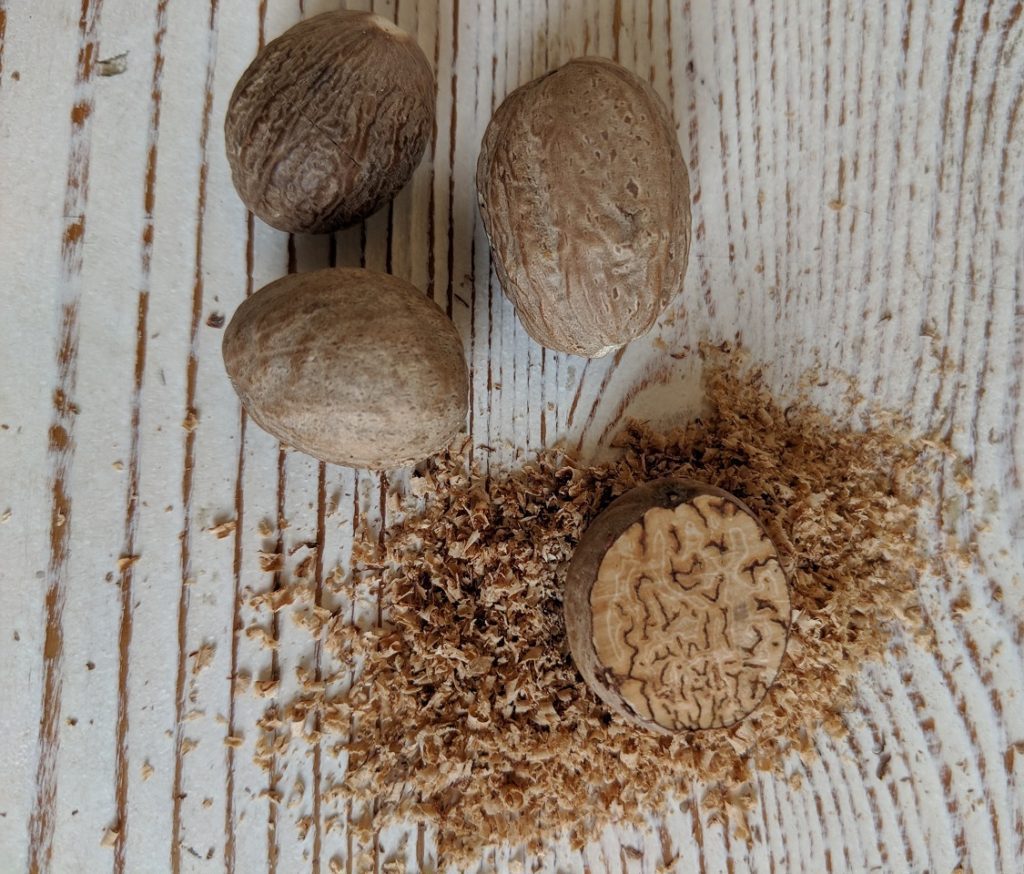
There are hepatoxic (toxic to the liver) substances in nutmeg, such as eugenol. However, the amount present in ground nutmeg is probably too low to cause any serious problems. And eugenol has benefits such as being antimicrobial, anti-inflammatory, anticancer, antioxidant, and neuroprotective.
Moreover, nutmeg is used in Traditional Chinese Medicine (TCM) to treat gastrointestinal diseases and some reports have indicated that nutmeg has hepatoprotective (liver-protective) activity.
Finally, nutmeg, and myristicin in particular, has been found to be hepatoprotective in a scientific study, meaning it could actually be protective of the liver, rather than toxic.
Nutmeg Side Effects
The side effects of nutmeg are considered rather unpleasant by many who experience them, which explains why the recreational use of the spice is unpopular despite its high availability and its legality.
In general, side effects become very pronounced when taking a strong dose (25 grams).
Here’s an (incomplete) list of the most common side effects which may be caused by ingesting large doses of nutmeg:
- anxiety, impending sense of doom, panic, distress, fear, apprehension
- confusion, disorientation, detachment
- shortness of breath/difficulty breathing
- hypotension – lowered blood pressure
- an excited state, agitation, irritation, restlessness
- headaches
- flushing, extreme coldness (hypothermia), increased body temperature, sweating
- paresthesia – abnormal dermal sensation (e.g., a tingling, pricking, chilling, burning, or numb sensation on the skin) with no apparent physical cause
- nausea, vomiting, gagging
- dizziness, giddiness
- dry mouth (“cottonmouth”)
- eye irritation, bloodshot eyes, pupil dilation, photophobia, blurred vision, nystagmus (a condition in which the eyes make repetitive, uncontrolled movements)
- visual changes, such as double and “triple” vision
- amnesia, memory disturbances, slowing of brain function
- sedation, collapse, blackouts, drowsiness
- irrational/bizarre behavior
- convulsions
- palpitations, tachycardia, accelerated/irregular/abnormal heartbeat, chest pains
- constipation, diarrhea, abdominal pain
- dehydration
- generalized body pain, numbness, muscle weakness
- difficulty/frequent urinating
- paranoia, deliriousness and delirium, psychotic episode (resembling an anticholinergic toxic episode)
- rarely death (when combined with other drugs.)
To counteract the effects of anticholinergics, cholinergics such as racetams may be taken.
Cannabis and caffeine too may somewhat inhibit the effects of nutmeg and other deliriants by inhibiting acetylcholinesterase, the enzyme which breaks down acetylcholine.
Interactions
Here’s a partial list of medications that may dangerously interact with nutmeg: flunitrazepam (Rohypnol), chlorzoxazone, theophylline, bufuralol, clozapine (Clozaril), cyclobenzaprine (Flexeril), fluvoxamine (Luvox), haloperidol (Haldol), imipramine (Tofranil), mexiletine (Mexitil), olanzapine (Zyprexa), pentazocine (Talwin), propranolol (Inderal), tacrine (Cognex), theophylline, zileuton (Zyflo), zolmitriptan (Zomig), phenobarbital (Luminal), phenelzine (Nardil), tranylcypromine (Parnate), isocarboxazid (Marplan), l-deprenyl (Eldepryl), and moclobemide (Aurorex/Manerix).
Also, do not take nutmeg with other MAOIs, such as Banisteriopsis caapi.
Addiction Potential
While most people will say that there’s no danger of addiction to nutmeg because the effects are too unpleasant, indigenous healers with experience of using nutmeg believe that a person can become “dependent” on this spice. I believe that while you cannot get addicted to nutmeg, you can become dependent on it and its euphoric effects, especially when the spice is used in low to moderate doses.
Anecdotal evidence suggests that some people can indeed become dependent on nutmeg:
today I found myself that I am in need of nutmeg. I crave for that buzz, not the nutmeg. No other substance is so easily accessible like nutmeg. I think that’s why I got addicted to nutmeg. Easily accessible, very very cheap and pot like buzz all day. These three factors made me addicted to nutmeg, I feel ashamed/embarrassed to label myself that I am a NUTMEG ADDICT!
Nutmeg Experiences
Below are some interesting nutmeg experiences from Erowid.org:
One person relates using nutmeg to lower his blood pressure. He also makes a suggestion for how to easily ingest nutmeg for beginners.
The most significant effect of nutmeg is as an anti-hypertensive. I have taken it regularly for over ten years for this reason. A side effect is a mild to strong sensory enhancement, and there is also some mystical/insightful sense enhancement as well. in my experience, the larger […nutmeg] tend to have more of a blood pressure reducing effect, the smaller ones seem to have more of a mood-enhancing effect. For my first time I would get a nutmeg the size of my index finger nail. Just pop it in my mouth as I would a hard candy. In a minute or two it will break up just as hard candies do, with a little crunching tooth pressure. I chew it up good and swallow it, and wash it down with a good glass of water. Nutmeg effects last a long time…. the peak is about 14 hours after I sink one. The effects last for 24-36 hours in my experience. It can be a bit disorienting so I would definitely not drive or use complex equipment for that time.
Next, some excerpts from experience reports. This guy provides some solid timing advice:
The onset is slow so the best time to take nutmeg is early in the morning, that way I can catch the full panorama. The other method is to take it late at night and wake up very tired and stoned. I prefer the first method. I typically peak around 12 hours into it, can feel it strong at around 8 hours into it, should be feeling some sort of apprehension or minor effects around five hours into it, and should have a bump of a pre-high, high energy experience around 30min-1hr into it. During and after the peak, concentration and memory will be shot to hell. During the 5-8 hour mark is the most mentally productive time. The mind is fertile with associations, and I often times find myself writing for hours ceaselessly on any topic, fictional or not, without significant impact on memory. The 8-16 hour mark is a different stage of the high, where I am most heavily dissociated from reality, and can cycle in and out of dreamstates by will.
Here’s a detailed and timed report which includes some good tips as well as an interesting insight into the use of nutmeg for improving dream recall.
1:00 p.m. I took some orange juice in my mouth and tilted my head back. I dropped the teaspoon of nutmeg into my mouth. Head titled back with the juice, I could not taste the nutmeg at all. I swallowed it all down; a faint taste of nutmeg could be tasted but nothing that would constitute a negative taste reaction. I continued in this fashion until all 3 teaspoons were taken. After consuming the nutmeg in this fashion the remaining taste was minimal and not at all unpleasant. 2:00 p.m. Minor effects were noticeable and comparable to those felt on my previous P. Cubensis experience. A heightened sense of being and clarity gave me reason to suspect the nutmeg was beginning to take effect. 4:00 p.m. Meditation breaks through into ‘the vibration’. Subtle and Gentle were the effects throughout the experience. In ‘The Vibration” I encountered many things as I did in that state with P. Cubensis. 11:00 p.m. Preparing for bed and feeling ready to sleep I have not felt any negative effects throughout the day and continue to feel positive and pleasant. I go to sleep and sleep fine. NEXT DAY 8:00 a.m. Awake, feeling pleasant and calm. ‘The Vibration’ is no longer felt but remains of the initial onset from the first hour or so of the previous day continue to be felt in a pleasant manner. Feelings that I would relate to a minor cannabis effect, subtle and pleasant. The rest of the second day passed in the same state. I went about my day as I always do unimpeded by any kind of negative after effect. FOLLOWING DAY 8:00 a.m. Awakening from a dream, remembering my dream, laughing out loud at the nonsense I was dreaming about I noted the ability to remember my dream with clarity. For the past few years I have not been able to remember my dreams. I normally pass the night in sleep, awakening into the new day with nothing hanging in my mind from a dream and normally feeling like I did not dream at all. This day I could vividly remember my entire dream which seemed like it went on for a long time and covered a lot of ground, places, people and activities.
Very interesting dream- and visual experiences generated by nutmeg:
I went to sleep just fine but before I fell asleep I felt my spirit like a vortex. As my dreams began to start I felt the presence of spirits communicating me through sensation and feelings. As if each of my thoughts was a specific conversation with a pocket of energy. My computer though shut down creaked and the vibration ran through me as if was awakened on an electro-magnetic level. Even on high amounts of LSD I’m not the type to see much for hallucinations. But I did have a visualization of an energy cloud around me as I lay in the meditative Nutmeg State.
Astral projection and lucid dreams following ingestion of nutmeg:
When I went to sleep within my dream, I could feel my spirit leaving my body and rising up, through the ceiling, up towards the clouds. Above the clouds was a strange white grid, which my spirit passed through easily. I was then in the upper layers of the atmosphere, looking out into the night sky. Out of the corner of my eye, I noticed a bright white light, and began moving towards it. As I got closer, it turned out to be Colonel Sanders, the white light was his aura shining so brightly. I was totally baffled at this point, and I felt very uplifted, and connected to the universe. Then the Colonel began talking to me. I can’t remember exactly what he said, only what he meant my all of it. He told me to keep going, keep pursuing my dreams and that everything was going to be good in the end. I don’t remember what happened next, only being awoke in my own bed by someone at the door. I could barely open my eyes, it felt like I had smoked an ounce of pot in my sleep. I drifted in and out of sleep for a couple hours, having very nice lucid dreams.
An experience of visuals during sleep:
just woke up from a sleep and the high is even more intense than earlier. I have been getting some closed eye visuals [during sleep]. They are not warm and welcoming kind, kinda apathetic, but they still are visuals nonetheless.
More lucid dreams:
visual distortions, which could be described as a purplish, shimmering haze in the dark, begin to intensify, taking on a swirling, whirlpool-like aspect. I also experience a number of ‘waking dreams’, each lasted from a few seconds to a few minutes before I snapped back to consciousness.
An interesting biographical dream experience:
a trance-like state ensued in which I was no longer observing the trip from my usual perspective, but instead was immersed in a dream. This was not like a lucid dream, at all; it was like being the character I was dreaming about, starting out as an infant. I gradually developed into a toddler without having any reflective thoughts about who I was or where I was. Up to this point the trance had lasted four or five hours, objective time, though my subjective dream time seemed infinitely longer. Then, as my dream perspective reached the age when personal memories had begun to form in my actual childhood, at about age 3 or 4, it occurred to me in the trance that I recognized my surroundings. In fact, the trance-dream’s scenery was the interior of the house I had lived in when I was that age. This broke the continuity of the experience, and from that point on for perhaps another hour I dreamed an increasingly speeding-up montage of short sequences, capturing scenes from my childhood and teen age years up to my actual age, which was 20 at the time.
While most people use nutmeg orally, I was able to find the following experience resulting from smoking the spice:
The nutmeg laced cigarettes I smoked produced a near hallucinogenic high with shadow and light boundaries becoming very pronounced and detailed textures becoming very interesting. However there was a bit of paranoia and the smoke wasn’t very enjoyable.
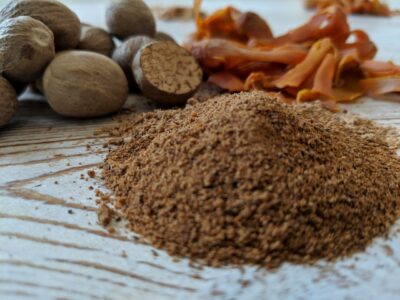
Nutmeg as an Ingredient/Substitute
Nutmeg can enhance the effects and work synergistically with other herbs. Here are some examples:
- Cannabis substitute/admixture – while some people use nutmeg instead of cannabis, others prefer to blend the two herbs together. There seems to be a synergism in work between constituents of nutmeg and anandamide (e.g., THC), the psychoactive substances in cannabis. Cocoa also contains anandamide, a substance similar to THC, by the way, so there’s no need to start smoking cannabis to test this combination. Simply, make a hot cocoa drink with nutmeg and black pepper.
- Sedative medicine with mace and other herbs
- Nutmeg flowers/leaves are used in Oriental Joy Pills type preparations (sedative, aphrodisiac, and analgesic)
- Ingredient in Absinthe
- Ingredient of bhang (a drink prepared from cannabis, spices, sugar, and milk)
- Damiana (Turnera diffusa) liqueur – aphrodisiac
- Ingredient in Mead
- Nutmeg seeds were used as a psychoactive beer additive in the Middle Ages, and in the US to this day
- Ingredient in Betel Quids
- Clareth/Luter drink – a German heavily spiced wine with honey, sugar, saffron, cloves, and nutmeg.
- Venezuela: nutmeg is mixed with tobacco leaves in Chimo preparations (tobacco paste)
- Morocco: it is taken together with the autumn mandrake to produce a “good head”
- India: preparations of nutmeg are used in place of opium when opium is contraindicated for a patient. A tonic is obtained using brandy and salt. In Yemen, the seeds are used as tranquilizers and the arils to treat headaches. Use as an aphrodisiac is still very widespread from India to Arabia and into Europe
- Ayahuasca admixture
- Cigarette smoke and soft drinks often contain myristicin and elemicin.
- For abortions, beer with nutmeg was drunk.
- Oilahuasca – The biochemical alchemy of combining allylbenzenes, such as myristicin in nutmeg, with actions affecting specific enzymes, to induce psychedelic experiences.
- With black pepper, which also contains myristicin. Some report a synergistic effect and an increase in hallucinogenic effects. One person who took 15 grams of nutmeg with 4-5 grams of black pepper) reported:
Effects are drastically different when black pepper is added to Nutmeg compared to the effects I get from nutmeg alone. I feel like everything is calm around me. Music sounds greater when tripping on Nutmeg, yes nutmeg gives you a trip. You will feel that you are in a different world when you close both of your eyes. Just a pinch of nutmeg is enough for better sleep. Take a teaspoon or two and you will have a sound sleep for about 20 hrs.
Conclusion: Nutmeg is a Sleep and Dream Spice
Nutmeg can be used to enhance dreams both during the daytime and the night. Ingesting it during the day can induce a dream-like quality and promote clear daydreams, while the dreams of the night may be more vivid, lucid, and recalled better.
This Dream Spice, as I have come to call it, doubles as a potential anti-depressant, anxiolytic, and aphrodisiac, among other beneficial qualities.
When using nutmeg as a Sleep Spice, it may be better to use powder, rather than essential oil since the non-essential oil part of the spice (trimyristin) seems to be responsible for its sedative effects. As the concluding quote suggests, just a pinch may suffice. (Don’t forget to try my Black Lentil Soup for Joyful Nights & Better Sleep.)
Remember to keep hydrated during nutmeg “trips” in order to minimize side effects, and to stick with the low end of the dose range.
It is Legal, except for…
Nutmeg is legal in most countries, with the exception of some Islamic countries. It is prohibited to import the spice into Saudi Arabia unless mixed with other spices in permitted proportions, which is no more than 20%.
It is obviously not recommended to take deliriants, such as nutmeg, without consulting with a doctor and a trip sitter to watch over you throughout the experience. (Check if, and where, I’m available to serve as a trip sitter.) With nutmeg, the sitter should ideally have experience with the spice and take some himself to enable the experiencing of shared effects, such as shared dreams, hallucinations, and out-of-body experiences.
P.S. This article was originally published on May 1, 2019, after a month-long research and experimentation I conducted during the month of April. Only toward the end of this intense and interesting period, did I find out that April is the month when nutmeg is harvested in its homeland – Indonesia. Must be a coincidence… or is it?



Mace and nutmeg smoked with cbd flowers in my bowl is Awesome